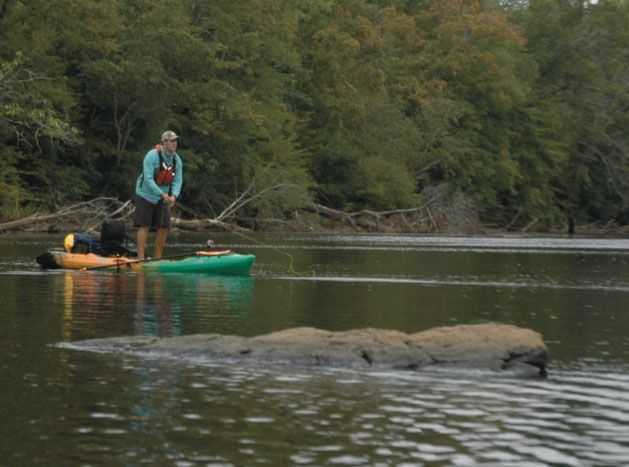When kayak fishing, there are times you will want to remain in the same location without being moved off your fishing spot by the wind, tide, current or waves. Also, when fishing rivers you may want to slow your drift down. There are various methods and techniques that allow you to accomplish this.
Stake-Out Pole: A stake-out pole is usually a fiberglass or aluminum rod 5 to 7 feet long with a point on one end. It’s driven into the bottom, when in an area shallow enough to allow, or into the bank. Usually a tether is attached to the handle end of the pole, and the other end of the tether is anchored to your kayak to hold you in place. The stake-out pole can also be inserted through the scupper holes to anchor a yak in place.
A stake-out pole can also be used as a push pole when in shallow areas. This can be handy in areas like inland marshes and flats.
Anchors: There are several types of hard anchors used for kayaking. The type anchor you should use depends on the environment.
1) The Bruce Claw: This is a great anchor with an abundance of holding power. However, this anchor only works on soft bottoms as it must dig into the bottom to hold. It is not that heavy, but it is kind of bulky because it does not fold.
2) The Folding Claw Anchor: These are what most kayakers will have, as they can be purchased as a complete anchor system, sometimes labeled as a “PWC anchor,” from stores like Walmart. They fold up for storage and are fairly compact. These do not hold as well as the Bruce claw but work pretty decently on a soft bottom.
3) The Weight Anchor: These are a great option when the bottom is hard and slick. They hold the kayak in place by sheer weight. These are simply a round lead ball about 4 inches in diameter with an attachment point for an anchor line.
Drift Chute: When fishing in deep water with wind or current, you may opt for a drift chute or sock. The drift chute is an awesome device that controls your speed by acting as a parachute in the water. When deployed, the drift chute will significantly slow your yak down allowing you time to work an area.
Drag Chain: When fishing shallow rivers like we have in north Georgia, a drag chain may be a good option. These are constructed from a piece of chain, sometimes covered with a bicycle innertube, and attached to a small- diameter rope. The chain is deployed from the front or the rear of the kayak to control the speed of the drift. The chain can vary in length and diameter. The heavier the chain, the more your drift will slow. A drag chain is less likely than an anchor to snag on underwater obstacles as it drags along the bottom. One word of caution, when using any type of mooring system in swift water, you can get into trouble if your device gets hung. It is not a good idea to use any type of anchor that is likely to snag rocks or trees in these situations.
Kelp or Brush Clip: This is nothing more than a short piece of rope attached to some kind of spring-loaded clamp. You use this by reaching out and clamping onto a limb, stump, root or kelp stalk to hold your yak stationary. These are made and sold retail; however, you can make your own from a plastic clamp that can be purchased at most hardware stores.
Safety and Retrieval Tips: When attaching a line to any anchor, it is a good idea to attach the line at the bottom of the anchor then use a small zip-tie to attach the line to the top of the anchor. That way if the anchor gets snagged on the bottom you can pull hard enough to break the zip-tie, and the anchor will reverse, allowing it to pull free.
When fastening any type of mooring device to your kayak, make sure to always move the attachment point to the front or rear of the kayak using an anchor trolley. A swift- moving current can pull down on one side of the kayak if the line is centered on the kayak resulting in a roll over.
Learning how to effectively deploy and handle your kayak will result in a safe and productive day on the water. Good luck.
[easy-social-share]
